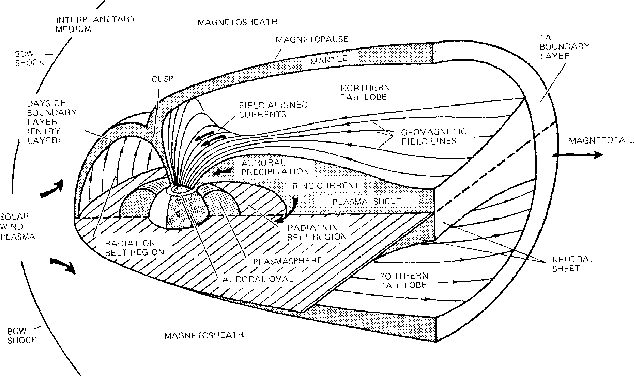As the solar wind approaches the earth, it interacts with the terrestrial
magnetic field forming the geomagnetic cavity. To a first approximation,
the earth's magnetic field close to the surface is a dipole field with its
north magnetic pole located at the geographic coordinates ![]() N,
N,
![]() W.
This really represents an approximation; for accurate work, the field is
expressed as a series of spherical harmonics [CB62]. Such representations are
accurate to about 0.5% near the surface (several hundred kilometers);
beyond 3 to 4 earth radii, the field is largely distorted due to the solar
wind. The geomagnetic cavity is formed
because the solar wind is not able to penetrate the geomagnetic field. Since
the solar wind is supersonic, a bow shock region forms on the solar side of
the magnetosphere. The magnetospheric
cavity is three-dimensional with a blunt nose region and an
extended tail. Figure 2.2
shows the shape as well as some
important regions of the magnetosphere, in a noon-midnight meridian plane
cross-section.
W.
This really represents an approximation; for accurate work, the field is
expressed as a series of spherical harmonics [CB62]. Such representations are
accurate to about 0.5% near the surface (several hundred kilometers);
beyond 3 to 4 earth radii, the field is largely distorted due to the solar
wind. The geomagnetic cavity is formed
because the solar wind is not able to penetrate the geomagnetic field. Since
the solar wind is supersonic, a bow shock region forms on the solar side of
the magnetosphere. The magnetospheric
cavity is three-dimensional with a blunt nose region and an
extended tail. Figure 2.2
shows the shape as well as some
important regions of the magnetosphere, in a noon-midnight meridian plane
cross-section.

Figure 2.2: Schematic representation of the magnetosphere (from M. C. Kelley)
A balance of particle kinetic pressure and magnetic pressure within the geomagnetic field and the incident solar wind defines the magnetopause, the outer limit of the magnetospheric cavity. Inside the magnetosphere are two types of field lines, closed field lines originating at low latitudes and forming closed loops of approximately dipolar form, and open field lines emerging from the polar regions. The latter are swept away from the sun to form an extended magnetotail. Between these regions are two regions, one on the dayside and one far back in the tail region, where the flux density falls to zero and neutral points are formed. The region between the bow shock and the magnetopause is called the magnetosheath. In crossing the shock, solar wind plasma is slowed down and the corresponding loss of directed kinetic energy is dissipated as thermal energy. The neutral point on the dayside magnetopause maps to the polar cusps, which are of great interest since they are regions where solar wind particles from the magnetosheath can enter the magnetosphere without having to cross field lines. These particles which enter the magnetosphere when frontside merging of the IMF with the earth's field lines occur, have energies ranging from tens to several hundred electron volts and they subsequently ionize localized regions on the dayside ionosphere.
The opened field lines have one end emerging from the polar cap of the earth and the other end attached to the IMF. They subsequently flow antisunward over the polar cap, forming a long structure called the magnetotail with a northern and a southern lobe. As shown in Figure 2.2, the geomagnetic field points in opposite directions in these two lobes. Between the lobes is the neutral sheet or plasma sheet; the magnetic pressure of the tail lobes is balanced by an enhancement of the plasma density in the plasma sheet. This plasma sheet is also the origin of particles precipitating at auroral latitudes. As the magnetic field lines in the magnetotail reconnect and jet back toward the earth, the average electron energy is boosted to energies of typically 1 - 100 keV. The plasma in this region provides the precipitation that produces the widespread visual emissions called diffuse and discrete aurora and acts as an ionization source on the nightside of the earth. The ionization resulting from particle precipitation in the ionosphere will be an important parameter in this thesis.
An index that summarizes the disturbance level of the geomagnetic field and
which will be used later in the experimental section is the ![]() index. It is
derived from the work of Bartels [Bar49]. The
index. It is
derived from the work of Bartels [Bar49]. The ![]() index is based on the range of magnetic field variation within 3-hour periods
as observed in the records from about a dozen magnetic observatories.
Measurements of the magnetic field are weighted and averaged to form
the
index is based on the range of magnetic field variation within 3-hour periods
as observed in the records from about a dozen magnetic observatories.
Measurements of the magnetic field are weighted and averaged to form
the ![]() value in a range from 0 (``very quiet'') to 9 (``very disturbed'')
in a quasi-logarithmic scale [May80].
value in a range from 0 (``very quiet'') to 9 (``very disturbed'')
in a quasi-logarithmic scale [May80].